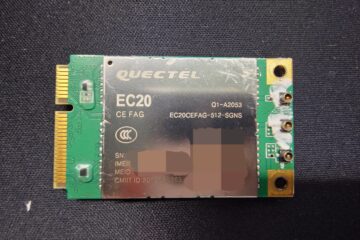原创文章,转载请注明出处
https://qiedd.com/
一、 准备工作
0. 材料
ArchISO 镜像站:中科大 清华 腾讯云 阿里云
U盘一个
电脑一台(需要联网)
将 ArchISO 写入U盘, 推荐使用Rufus,轻巧简便
请使用DD方式写入!
启动方式选择UEFI
1. 启动到 ArchISO
启动到 ArchISO 后,我们需要连接网络,有些连接直接插网线就能通过 DHCP 获取到 IP
若为无线连接,则需要手动连接到 WiFi
ArchWiki 给我们提供了方法 https://wiki.archlinux.org/title/Iwd
# 使用iwctl连接WiFi
iwctl
# 查看设备
[iwd]# device list
# 如果知道的SSID和密码,可以直接连接到WIFI,我的设备为wlan0
[iwd]# station wlan0 connect 你的SSID
# 如果不知道SSID,则需要扫描WiFi
[iwd]# station wlan0 scan
# 获取扫描到的WiFi信息,然后再连接到WiFi
[iwd]# station wlan0 get-networks
# 连接到后推出即可
[iwd]# exit
# 然后查看获取到的IP
ip a
# 这是我的网卡
device list
NetworkConfigurationEnabled: disabled
StateDirectory: /var/lib/iwd
Version: 1.20
[iwd]# device list
Devices *
--------------------------------------------------------------------------------
Name Address Powered Adapter Mode
--------------------------------------------------------------------------------
wlan0 ff:ff:ff:ff:ff:ff on phy0 station
(可选)由于远程操操作命令一个个打很麻烦,我选择使用 SSH 连接后复制命令,因此我们需要设置密码和启动 sshd
# 启动sshd systemctl start sshd # 设置密码 passwd # 可以用windows自带的SSH功能,使用CMD即可 ssh root@你的ip
二、开始安装
0. 硬盘分区
在安装之前,我们需要硬盘分区,这里我使用的是 Windows11 + Arch 双系统,Windows11 和 Arch 都在一个盘上
# 查看硬盘分区 fdisk -l # 这是我需要安装的硬盘 Disk /dev/nvme0n1: 953.87 GiB, 1024209543168 bytes, 2000409264 sectors Disk model: SAMSUNG MZVLB1T0HBLR-00000 Units: sectors of 1 * 512 = 512 bytes Sector size (logical/physical): 512 bytes / 512 bytes I/O size (minimum/optimal): 512 bytes / 512 bytes Disklabel type: gpt Disk identifier: 88050E2B-CEC0-4FFE-9216-0C148782F384 Device Start End Sectors Size Type /dev/nvme0n1p1 2048 206847 204800 100M EFI System /dev/nvme0n1p2 206848 239615 32768 16M Microsoft reserved /dev/nvme0n1p3 239616 837517311 837277696 399.2G Microsoft basic data /dev/nvme0n1p4 837517312 838860799 1343488 656M Windows recovery environment
这里我的分区选择是
1G的EFI分区,剩下的空间都作为 Arch Linux 的根分区
如果你在一块全新的硬盘上安装
在创建分区时,请先使用 ’g‘ 来创建一个 GPT硬盘
或者使用 ’o‘ 来创建一个 MBR 硬盘
# 对/dev/nvme0n1进行硬盘分区
fdisk /dev/nvme0n1
# 分区步骤,默认回车
root@archiso ~ # fdisk /dev/nvme0n1
Welcome to fdisk (util-linux 2.37.2).
Changes will remain in memory only, until you decide to write them.
Be careful before using the write command.
# 创建一个1G的分区
Command (m for help): n
Partition number (5-128, default 5):
First sector (838860800-2000409230, default 838860800):
Last sector, +/-sectors or +/-size{K,M,G,T,P} (838860800-2000409230, default 2000409230): +1G
Created a new partition 5 of type 'Linux filesystem' and of size 1 GiB.
# 将剩下空间都给/分区
Command (m for help): n
Partition number (6-128, default 6):
First sector (840957952-2000409230, default 840957952):
Last sector, +/-sectors or +/-size{K,M,G,T,P} (840957952-2000409230, default 2000409230):
Created a new partition 6 of type 'Linux filesystem' and of size 552.9 GiB.
# 更改分区/dev/nvme0n1p5的分区类型
Command (m for help): t
Partition number (1-6, default 6): 5
Partition type or alias (type L to list all): 1
Changed type of partition 'Linux filesystem' to 'EFI System'.
# 写入,保存设置
Command (m for help): w
The partition table has been altered.
Calling ioctl() to re-read partition table.
Syncing disks.现在我们再看一下这块硬盘的分区
# 查看硬盘/dev/nvme0n1的分区 fdisk -l /dev/nvme0n1 Disk /dev/nvme0n1: 953.87 GiB, 1024209543168 bytes, 2000409264 sectors Disk model: SAMSUNG MZVLB1T0HBLR-00000 Units: sectors of 1 * 512 = 512 bytes Sector size (logical/physical): 512 bytes / 512 bytes I/O size (minimum/optimal): 512 bytes / 512 bytes Disklabel type: gpt Disk identifier: 88050E2B-CEC0-4FFE-9216-0C148782F384 Device Start End Sectors Size Type /dev/nvme0n1p1 2048 206847 204800 100M EFI System /dev/nvme0n1p2 206848 239615 32768 16M Microsoft reserved /dev/nvme0n1p3 239616 837517311 837277696 399.2G Microsoft basic data /dev/nvme0n1p4 837517312 838860799 1343488 656M Windows recovery environment /dev/nvme0n1p5 838860800 840957951 2097152 1G EFI System /dev/nvme0n1p6 840957952 2000409230 1159451279 552.9G Linux filesystem
在安装之前,我们还需要对分区进行格式化
这里的 Bootloader 我们选择了 System-boot https://wiki.archlinux.org/title/Arch_boot_process#Feature_comparison
在 Wiki 上我们知道使用 System-boot 仅支持 UEFI 启动方式
并且 EFI 分区需要为 FAT 格式
# 格式化EFI分区 mkfs.vfat -F 32 /dev/nvme0n1p5 # 格式化根分区为ext4 mkfs.ext4 /dev/nvme0n1p6
接下来我们需要将系统安装进分区中
但在之前我们需要先挂载硬盘,才能进行读写
# 挂载根分区到/mnt mount /dev/nvme0n1p6 /mnt # 创建/boot分区 mkdir /mnt/boot # 挂载/boot分区 mount /dev/nvme0n1p5 /mnt/boot
1. 安装系统
然后我们就需要将系统安装进去了
在此之前,我们需要选择一个镜像源来下载
自带的都是国外源,慢的要死
我个人推荐使用中科大的源,清华的v4有时候会断流
# 编辑镜像源 vim /etc/pacman.d/mirrorlist # 添加镜像源,优先使用最前面的,请自行选择 Server = https://mirrors.ustc.edu.cn/archlinux/$repo/os/$arch Server = https://mirrors.tuna.tsinghua.edu.cn/archlinux/$repo/os/$arch Server = https://mirrors.cloud.tencent.com/archlinux/$repo/os/$arch Server = https://mirrors.aliyun.com/archlinux/$repo/os/$arch
接下来就是安装系统了
需要根据你的CPU来安装支持
# AMD pacstrap /mnt base linux linux-firmware base-devel vim os-prober amd-ucode openssh wget networkmanager # INTEL pacstrap /mnt base linux linux-firmware base-devel vim os-prober intel-ucode openssh wget networkmanager
2. 配置系统
为了让内核知道该硬盘该如何挂载
我们需要 /etc/fstab 来告知它
# 生成 /etc/fstab genfstab -U /mnt >> /mnt/etc/fstab # 查看配置是否正确 cat /mnt/etc/fstab
我们还需要去配置我们刚刚安装的系统,因此需要chroot
# 挂载的分区在/mnt中,因此chroot到这个地方 arch-chroot /mnt # 配置时间分区 ln -sf /usr/share/zoneinfo/Asia/Shanghai /etc/localtime hwclock --systohc date # 语言支持 vim /etc/locale.gen # 将需要的语言放在最前面保存即可 en_US.UTF-8 UTF-8 zh_CN.UTF-8 UTF-8 zh_TW.UTF-8 UTF-8 # 安装 locale-gen # 配置默认语言 vim /etc/locale.conf # 添加到文件中,保存 LANG=en_US.UTF-8 # 设置Hostname hostnamectl set-hostname 你的Hostname # 设置hosts vim /etc/hosts # 添加到文件中 127.0.0.1 localhost localhost.localdomain localhost4 localhost4.localdomain4 ::1 localhost localhost.localdomain localhost6 localhost6.localdomain6
为了保证系统能够启动,我们还需要将 System-boot 安装进 /boot 分区中
# 在此之前,我们需要先获取到根分区的UUID,我的是/dev/nvme0n1p6,你需要自行查看自己的 lsblk -f # 安装System-boot bootctl --path=/boot$esp install # 启动配置 vim /boot/loader/loader.conf # 留下这些配置即可 default arch.conf timeout 4 console-mode auto editor no # 启动项 vim /boot/loader/entries/arch.conf title Arch Linux linux /vmlinuz-linux initrd /intel-ucode.img initrd /initramfs-linux.img options root=UUID=你的分区的UUID rw # AMD title Arch Linux linux /vmlinuz-linux initrd /amd-ucode.img initrd /initramfs-linux.img options root=UUID=你的分区的UUID rw
在安装的最后,我们还需要配置一些第三方源
ArchLinuxCN源
# 编辑配置文件 vim /etc/pacman.conf # 将此项加到最后面,保存退出 [archlinuxcn] Server = https://mirrors.ustc.edu.cn/archlinuxcn/$arch # 安装ArchLinuxCN-keyring pacman -Sy archlinuxcn-keyring
最后的最后,还需要设置密码
和让一些服务自启动
# 设置root密码 passwd # 等下启动还要继续配置,先把ssh的允许root登录开了 vim /etc/ssh/sshd_config # 找到PermitRootLogin prohibit-password改成yes PermitRootLogin yes # 网络管理自启动,不启动连不上网 systemctl enable NetworkManager # 推出chroot exit # 取消挂载 umount -R /mnt # 重启 reboot
三、启动后配置
1. 配置系统
# 如果需要WiFi联网 nmtui # 启动sshd systemctl start sshd # 查看IP ip a # 开启ntp时间同步 timedatectl set-ntp true # 双系统需要,不然时间会差8小时 timedatectl set-local-rtc 1
2. SHELL的选择
默认是 Bash,Bash确实很优秀,但还有许多优秀的 Shell,比如说 zsh,fish
这里我使用了FISH
# 安装fish pacman -S fish # 查看所有的Shell chsh -l # 选择默认Shell chsh -s /bin/fish # 创建一个用户 useradd -m -g users -s /bin/fish username # 给这个用户设置密码 passwd username # 配置sudo权限 vim /etc/sudoers # 在root下方添加,我们这里配置了免密码 root ALL=(ALL) ALL username ALL=(ALL) NOPASSWD:ALL


2 条评论
koali · 2023年10月25日 下午11:51
1G的EFI分区?这个分区为什么要给这么大啊?
Lordpenguindd · 2023年10月26日 上午12:38
这个分区随便给,我放那么大只是因为可以塞个 Archiso,出问题可以直接 grub imageboot